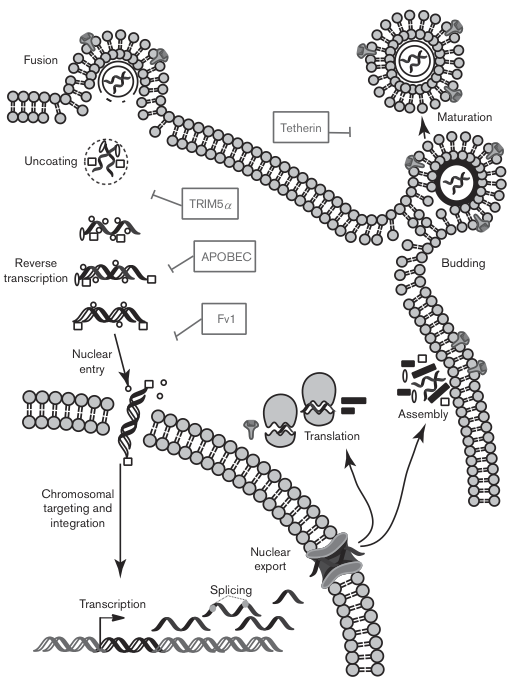Harriet C.T. Groom and Kate N. Bishop
MRC National Institute for Medical Research, London, UK
(PDF freely available from the journal)
Thanks Maarten Maartensz (and CO-CURE) for the link!
Retrovirus life cycle and targeting by host restriction factors.
So much for the basics.Simplified schematic of the life cycle of a simple exogenous retrovirus (scale and numbers are illustrative only).Major stages of replication:
Host restriction factors:
- Fusion
- Uncoating
- Reverse Transcription
- Nuclear Entry
- Chromasomal Targeting and Integration
- Transcription
- Splicing
- Nuclear Export
- Translation
- Assembly
- Budding
- Maturation
- APOBEC3G inhibits cDNA synthesis and induces mutation of the virus genome
- TRIMα targets the virus at a stage after entry but before reverse transcription
- Fv1 inhibits replication after reverse transcription but before integration
- Tetherin prevents mature virus-particle release (budding/maturation) from the cell
… The Xpr1 receptor is expressed widely on human cells (Kozak, 2010) and XMRV was demonstrated to infect various human cell lines, including those derived from PC [Prostate Cancer] (Dong et al., 2007; Groom et al., 2010b; Rodriguez & Goff, 2010; Stieler et al., 2010). However, infection appeared to be inhibited in other cell types in vitro (Groom et al., 2010b; Stieler et al., 2010). …Translated to english: XMRV can infect some cell lines, in the lab ("in vitro"), but some other cell lines inhibit XMRV infection.
… No APOBEC3G was detected in PC cell lines or primary prostatic stromal fibroblasts (Paprotka et al., 2010; Stieler et al., 2010), perhaps explaining the efficient replication of XMRV in these cells. …
Translated to english: XMRV spreads in some cell lines, because some cell lines are missing bits and pieces, which are present in human PBMCs in vivo.
As well as requiring the correct receptor, the species specificity and tissue tropism of a virus are in part determined by the expression of a range of cellular restriction factors. Some restriction factors found in human PBMCs have previously been shown to inhibit MLV replication (Fig. 1), so it was surprising that XMRV could reportedly be isolated from blood (Lombardi et al., 2009). Intrigued by the possibility that XMRV had mechanisms to overcome restriction factors that other MLVs lacked, we and others investigated the susceptibility of XMRV to these factors (Bogerd et al., 2011; Groom et al., 2010b; Paprotka et al., 2010; Stieler & Fischer, 2010). We showed that members of the human APOBEC3 family, as well as Tetherin, were able to restrict XMRV infection, although human TRIM5α was not. APOBEC3G and Tetherin are expressed in PBMCs, so it was unlikely that XMRV could maintain an efficient spreading infection in these cells.
Translated to english: Anybody telling you that XMRV spreads in human PBMCs is full of shit.
Neither XMRV nor their ancestoral MLV's have capablities to overcome human defenses against retroviruses. They can not infect a human (these viruses can not "maintain an efficient spreading infection").
As a end-note: The mystical "HGRV", which is rumored to be a relative of MLV's and to have gathered several capabilities to overcome human anti-retroviral defenses – capabilities which are missing in his relatives – has so far not been demonstrated to exist. Maybe it is spread by animals living in the Bavarian forest…
Neither XMRV nor their ancestoral MLV's have capablities to overcome human defenses against retroviruses. They can not infect a human (these viruses can not "maintain an efficient spreading infection").
As a end-note: The mystical "HGRV", which is rumored to be a relative of MLV's and to have gathered several capabilities to overcome human anti-retroviral defenses – capabilities which are missing in his relatives – has so far not been demonstrated to exist. Maybe it is spread by animals living in the Bavarian forest…
In Bavarian folklore, a wolpertinger (also called wolperdinger, poontinger or woiperdinger) is an animal said to inhabit the alpine forests of Bavaria in Germany. It has a body comprised from various animal parts — generally wings, antlers, tails and fangs, all attached to the body of a small mammal. The most widespread description is that of a horned rabbit or a horned squirrel.
Stuffed "wolpertingers", composed of parts of actual stuffed animals, are often displayed in inns or sold to tourists as souvenirs in the animals' "native regions". The Deutsches Jagd- und Fischereimuseum in Munich, Germany features a permanent exhibit on the creature.
It is similar to other creatures from German folklore, such as the Rasselbock of the Thuringian Forest, or the Elwedritsche of the Palatinate region, which is described as a chicken-like creature with antlers; additionally the American Jackalope, as well as the Swedish Skvader are in ways similar to the Wolpertinger.


No comments:
Post a Comment
Comments are most welcome! But please:
- No SPAM whatsoever, no supplements, no pharmaceuticals, no herbs or any other advertisements
- Absolutely no quack-doctors pushing their quack-BS websites (and if you are a quack, I will call you out)
- Be critical if you want to, but try to be coherent
Comments are moderated, because I am tired of Gerwyn-V99-The-Idiot and his moronic sockpuppets, and tired of the story of the two dogs, but I will try to publish everything else.
If you are not Gerwyn (and want to tell me something other than the story of the two dogs), then relax and write something! :-)